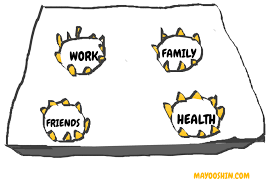This is a multi-part Series on Discipline and Accountability
As mentioned, this is a multi-part series focusing on “discipline and accountability”. This will be a tough “row to hoe”. Why? Comparing business (private sector) to public sector (government) isn’t really done much. Honestly, most of the direct comparisons are done within the scope of “the forming of our US Constitution and the founders of this blessed document. Within it, the private sector intentioned the forming a free-will republic where government needed to be formed but answerable to We The People. I will be jumping into this more in Part 2 and Part 3. The goal here is to reveal the elephant in the room… “right choices are rarely agreed upon entirely by those within much less those without and yet must be made nonetheless”.
Obviously, most rescue and rigging professionals are within the public sphere (fire and SAR being the majority) and yet, private enterprise is fast approaching a very high level of expertise as “health and safety” becomes more and more a concerned priority.
Fire has different priorities than does SAR. Both receive their funding from the private sector, but in different form, thus the function of the units are different. Private rescue teams are unique in their form in that there can be a mix of “staffed personnel trained to a certain level of expertise” while leaving other elements left to “contracted work”… be it Fire and or a “private” company staffed largely through “fire guys”.
Both Private and Public have a “supply chain”… It isn’t that one produces and the other uses, moreover it is a two-sided coin where both mutually serve the other and where the citizens are the recipient of both goods and services…and the citizens are in fact the funders of both.
So with this, I will jump directly into the 4 Burners and the contrast of making the tough decisions more effectively.
The Four Burners Theory – the idea that successful people prioritize four key areas: family, friends, health, and work – can help us to make smarter decisions about our priorities. We can also use the Pareto Principle – the concept that 80% of results come from 20% of effort – to get more done with less. By understanding these concepts and applying them to our lives we can become more efficient in our time management, improve our decision-making skills, and lead more successful lives.
Living a disciplined business life means doing more with less. The concept of getting more done with less is often referred to as the 4-burner theory, which suggests that successful business leaders prioritize four areas of their life:
- business
- family
- health
- friends
We have a few options in making decisions. Don’t get lost in the analogy and “metaphorical”.
- Outsource
- Embrace Constraints
- Break things up into “seasons”
Obviously, cutting or removing burners have some serious and deleterious consequences, so working through “seasons” would make more sense for most.
In business life (here on out is referring to our jobs and responsibilities therein), it’s important to make decisions and take action in order to drive success. Too often business people focus on too many tasks at once which can lead to distraction from the priority and goal. In order to get more done with less, business leaders must understand how best to use their limited resources — time being the most critical asset — in order to reach success.
Business people must identify what it is they want out of their business and prioritize those goals over day-to-day tasks that may not be as important. Once business leaders have identified their priorities they can begin working towards them by taking calculated risks and making smart decisions along the way. Taking calculated risks involves using data and research in order to make informed decisions rather than relying purely on intuition or guesswork.
Having a clear vision of what one wants out of their business is essential for successful decision-making in business life; this includes understanding one’s own strengths and weaknesses so that resources such as personnel time can be utilized effectively in order for business leaders to get the most out of every decision. Business leaders must also have a plan for execution, understanding all potential outcomes before making a commitment so that they can avoid costly mistakes down the line.
Effective communication between business partners is also essential for getting more done with less; this includes having regular meetings where everyone involved has an opportunity to discuss concerns and rationalize decisions that need to be made in order for business objectives to be achieved efficiently and cost-effectively. Having open discussion between team members allows for better collaboration, problem solving, and idea generation which are all key components of efficient decision making processes.
Finally, business leaders must learn how best to manage stress while still staying focused on the task at hand; this requires taking time away from work related duties as well as practicing self-care activities such as exercising regularly or taking breaks throughout the day in order to maintain mental clarity and focus when needed most.
Overall, living a disciplined business life means doing more with less by prioritizing goals over daily tasks—focusing on smart decision making processes through research-driven risk assessment—as well as effective communication among business partners coupled with sound stress management practices; these are all key components when attempting to get more out of your everyday efforts without sacrificing long term success!
In Part 2, I will be covering the convergence of both public and private and how this effectually weaves through rigging and rope rescue.
Peace on your Days!
Lance










